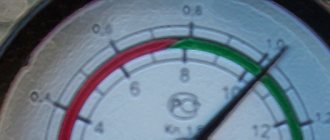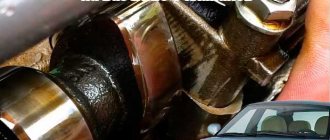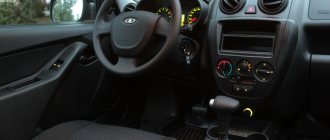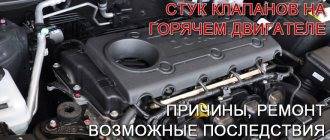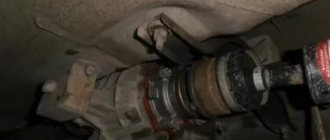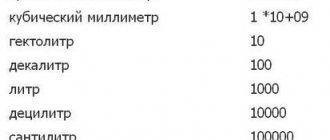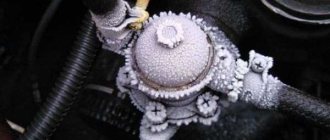Installation price of 2nd generation gas equipment
HBO 2nd generation “Gas carburetor” is installed on cars only with a metal intake manifold.
Gas consumption increases by 5-7% compared to gasoline. If the manifold is plastic (usually cars after 2001), in order to avoid breakdowns, it is necessary to install a 4th generation Italian-made LPG system on Russian and Ukrainian-made cars (propane-butane), a “gas carburetor” system. LPG for VAZ, LPG for Gazelle, LPG for Tavria, LPG for VAZ 2110, LPG for VAZ 2106, LPG for VAZ 2109, LPG for VAZ 2115, LPG for VAZ 2107 carburetor, LPG for VAZ 2107, LPG for VAZ 2106, LPG price for VAZ 21099
The price of 2nd generation HBO includes:
- Gearbox "LOVATO" (Italy)
- Mixer and other components
- *Cylinder for spare tire 42 l or at customer’s choice with surcharge depending on volume
- Installation and configuration of 2nd generation HBO
- Documents in the traffic police
Price of HBO-4
| car model | Cylinder size, l. | Price, USD |
| HBO price - VAZ 2101-2107, Tavria, Slavuta. | 50, 40, 30 | 410 USD |
| Price of HBO - VAZ 2104, 2108-2109 carburetor | 40 (instead of “spare tire”) | 440 USD |
| Price of HBO - VAZ injection | 50 | 410 USD |
| Price of HBO - VAZ injection | 40 (instead of “spare tire”) | 440 USD |
| LPG price - ZAZ "Tavria" pickup | 50 (cylinder above the cabin) | 410 USD |
| Price of LPG - VAZ 2121 "Niva" carb./injection. | 50 (cylinder under body) | 410 USD |
| LPG price - GAZ-24..3110 "Volga" carb. | 60 | 410 USD |
| Price of HBO - GAZ-3110 "Volga" injector | 60 | 410 USD |
| HBO price - "Gazelle" side, all-metal. | 90 | 410 USD |
| Price of HBO - "Gazelle" cargo pass. "duet" | 60 | 410 USD |
| Price of HBO - UAZ | 60 | 410 USD |
| Price of HBO - GAZ 52, 53, 3307 "Lawn" | 100 | 410 USD |
| Price of HBO - ZIL - 130 | 100 | 410 USD |
| Gas injector (GBO 4th generation) distributed injection, Italy | Price, USD cylinder - cylindrical 50l / for spare tire 42l* |
| HBO 4th generation (4 cylinders) | price 550 USD |
| HBO 4th generation (5 cylinders) | price 750 USD |
| HBO 4th generation (6 cylinders) | price 750 USD |
| HBO 4th generation (8 cylinders) | price 950 USD |
The price of HBO 4 includes:
- Control unit (computer) STAG 4 (Italy + Poland)
- Gearbox "TOMASETTO" (Italy)
- Injectors “VALTEK” (Poland) or “HANA” (+150 euros)
- *Cylinder for spare tire 42 l or at customer’s choice with surcharge depending on volume
- Installation and configuration of 4th generation HBO
- Documents in the traffic police
4th generation LPG is installed on cars only with electronic (full) injector. Gas is supplied through nozzles controlled by a special computer. Engine power does not decrease, gas consumption is several percent more than gasoline.
Autonomous mileage after switching to gas
Autonomous mileage 2107 with gas equipment
| Volume | Transfers | Cylinder capacity | Refilling the cylinder | Total autonomous mileage | ||
| Around town | On the road | Mixed | ||||
| 1.3 | Mechanics | 47 l. | ||||
| 1.3 | Mechanics | 47 l. | ||||
| 1.5 | Mechanics | 47 l. | ||||
| 1.6 | Mechanics | 47 l. | ||||
| 1.6 | Mechanics | 47 l. | ||||
| 1.7 | Mechanics | 47 l. | ||||
| Price per liter of gas in calculations: CIS - 22.00 ₽. | ||||||
HBO doubles the autonomous mileage of the VAZ 2107 1982...2012 sedan. Now there is definitely enough fuel for the longest trips.
Call to ask questions, consult with a specialist or sign up for installation in Moscow (24 hours a day) or write to [email protected]
Certified multi-brand center for installation, maintenance and repair of gas equipment:
Gas Performance Benefits
IN COMBINATION, THESE FACTORS EXTEND THE ENGINE LIFE BY
Gas extends the life of oil and spark plugs and reduces vehicle maintenance costs.
Gas burns a little slower than gasoline, which reduces the load on the piston group and crankshaft, causing the engine to run smoother.
The gas mixes easily with air and fills the cylinders more evenly with a homogeneous mixture, so the engine runs smoother and quieter. The gas mixture burns almost completely, so no carbon deposits form in the pistons, valves and spark plugs.
The octane number of petroleum gas is 103-105, which virtually eliminates detonation of engine parts. This advantage of gas can be especially important for engines with a high compression ratio that consume high-octane (and therefore expensive) gasoline.
The gas does not contain harmful impurities (lead, sulfur), which at the chemical level destroy the combustion chamber parts, catalytic converter and lambda probe.
The gas enters the engine in the vapor phase, so it does not wash away the oil film from the walls and does not dilute the oil in the crankcase.
Savings on fuel are greater than the overpayment on the loan
First payment 0 rub.
Loan term from 1 month
Loan cost 1.6% per month
Loan decision in 15 minutes
Switch to gas and start saving
You will get back the overpaid money for using a two-year loan in the second month of operating the system.
On average, the savings per year when driving on gas is 50,000 rubles.
Save up to 200,000 rubles per year
1 km of mileage on gas is 2 times cheaper than 1 km of mileage on gasoline
Calculate the savings of driving on gas compared to using gasoline
1. Select your car
For example: Peugeot Partner, Citroen Berlingo, Renault Kangoo, VW Caddy
2. Indicate the mileage of your car per year
Having extensive experience in operating gas equipment (already the 4th car on gas!), I can confidently say that AGTS specialists are the best professionals in converting cars to gas in St. Petersburg. no less than 100 percent. The feeling is super, if you have any doubts, I highly recommend it.
This is the second time I've come here. Hyundai Accent is my second car and, accordingly, my second LPG. Just like the first time, I installed Italian equipment from Lovato. It seems to me that it is the best. At least it’s very easy to set up, which can’t be said about other systems. And stability in operation: the settings are the same as they are. In total, I have been using HBO for 4 years now, and no problems. The most important thing is to regularly visit maintenance and immediately correct errors if something is wrong.
For me, LPG is no longer new - I’ve been driving gas for almost 10 years, and I install it on every new car. I think it’s not worth describing all the delights of the equipment, and a lot of things have already been told without me. I’ll tell you better how the installation of gas equipment in the AGTS went. I made an appointment with the guys a week in advance, arrived at the appointed time, and they were already waiting for me. The box is large and well equipped. Two people are allocated for each car, everything is done quickly and smoothly. I stood there, watching them. It is immediately clear that the team has worked well together. One installs the wiring, the other connects the cylinder. It’s obvious that they know their job here: every car is there – and on the day I arrived, it was sold out. Everyone is busy, there is no unnecessary talk, just business. At this rate, they installed the HBO for me for about two hours, probably, then one worker explained how it works, what is connected to what, etc. That is, in addition to the fact that they quickly installed it, they also gave instructions on how to use it and what to do if something goes wrong. This, it seems to me, is just great for those who are encountering HBO for the first time. And I, an experienced gas driver, was pleased to listen) In general, I recommend it!
Price for installing gas treatment methane
| Methane for passenger cars. | |
| car model | Price, USD |
| 4 cylinders | 560 USD |
| 5 cylinders | 673 USD |
| 6 cylinders | 673 USD |
| 8 cylinders | 750 USD |
| Methane for trucks. | |
| car model | Price, USD |
| Gazelle all-metal | 270 USD + 77 USD per cylinder |
| Gazelle onboard | 270 USD + 77 USD per bottle |
| GAS light cylinders | 270 USD + 77 USD per cylinder |
| GAS heavy cylinders | 270 USD + 39 USD per cylinder |
| ZIL cassette | 270 USD + 39 USD per cylinder |
| ZIL board | 290 USD+39 USD per cylinder |
Gas consumption and savings
Propane consumption for sedans 2110, savings
| Engine | Gas type | Propane consumption modes | Fuel cost per 1000 km in city mode | ||||
| City | Route | Mixed | Petrol | Propane | Saving | ||
| 1.5 MT | CIS | 9,7 | 6,7 | 8,3 | RUB 3,018 | RUB 1,805 | |
| 1.5 MT | CIS | 10,8 | 6,7 | 8,1 | RUB 3,667 | RUB 2,010 | |
| 1.6MT | CIS | 8,3 | 5,8 | 7,9 | RUB 2,807 | RUB 1,545 | |
| 1.8MT | CIS | 10,8 | 6,7 | 8,5 | RUB 3,667 | RUB 2,010 | |
| 2.0MT | CIS | 11,6 | 7,2 | 9,1 | RUB 3,929 | RUB 2,159 | |
| LPG - liquefied petroleum gas (a mixture of propane and butane). Price per liter of propane in calculations: CIS - 18.61 rubles. | |||||||
Possible problems
An injection engine becomes, in fact, a carburetor engine. This is where all the problems come from. The fact is that when the engine is running on gas, there is no longer air in the intake manifold (as with gasoline), but a working mixture of gas and air, which, under certain conditions, a spark from under the valve, say, can “pop” - i.e. e. a so-called “reverse clap” will occur. The result is failure of the mass air flow sensor (if any), or it may simply rupture the air casing. And the possibility of this always exists, no matter what equipment you install!
Although from experience we can say that the Japanese practically do not clap, the Volgas sooner or later begin to clap, the Grand Cherokee 5.2 is not even worth trying, it clogs your ears.
Causes
Increased fuel consumption in a car may depend on several reasons; below we will present elements of the LPG system that can influence the increase in gas mixture consumption by the car.
Gas leak
We highlighted this reason first not only because it is one of the most common, but also because this reason poses a huge danger when operating a vehicle. Leaky connections, wear of rubber pipes or lines lead to increased gas consumption not long in coming. It should be understood that the absence of a gas smell in the car interior does not always mean that there is no leak. To identify and eliminate this cause, you should contact a specialized service station or independently check all connections and pipes for leaks by soaping.
Air leak
Leakage of the LPG system not only affects the vehicle's increased consumption of the gas mixture, but can also cause air leaks, which in turn leads to increased fuel consumption and loss of vehicle power.
Gearbox
Over time, wear of the main elements of the gearbox can cause increased gas consumption in the car. In case of failure of the gearbox or one of its components, you can use the repair tool. a kit to restore the functionality of this element of the HBO system. In most cases, the performance of the gearbox can be restored. If this is not possible, the gearbox will have to be replaced.
Gas injectors
Contamination or failure of gas injectors can also cause increased gas consumption in a car to be an unpleasant experience for the owner every day. This reason is only valid for 4th generation HBO.
Solution to the popping problem
GWO installation of the 4th generation, with distributed gas injection. There is nothing to clap about here, there is again air in the intake manifold, gas injectors are located next to gasoline ones. The gas controller calculates the opening time of gas injectors based on readings of gas temperature, pressure, engine speed, vacuum in the intake manifold, and most importantly, the opening time of gasoline injectors, which is calculated by the gasoline controller based on the readings of a bunch of sensors (detonation, throttle position, TDC, air flow, temperature, etc.) and most importantly the oxygen sensor (lambda probe). Those. The gasoline power system must be in good working order, otherwise it will not work correctly on gas.
This is why there is such a difference in price for HBO 4 and HBO 2, and installation takes a whole day, then configuration (no screws, just from the computer).
Almost every car enthusiast who has installed gas equipment on his vehicle is faced with finding a solution to a problem called: “how to reduce gas consumption on a 4th generation LPG car?”
There may be several reasons for an increase in engine appetite. And not every one of them is worth sounding the alarm and rushing to the gas installers. Some you can identify yourself using the tips below. For their practical implementation you will need a sober mind, common sense and acquired knowledge.
Reasons for increased gas consumption
Many factors can be common reasons for all machines with different generations of gas equipment, for example:
- gas mixture leak;
- ratio of propane to butane for winter operation (the amount of butane in the winter mixture is reduced, and since its energy efficiency is higher, fuel consumption increases by about 3-5%);
- clogged gas filters;
- operation in cold climates (frequent warm-ups);
- moving with a load (trailer, loads);
- engine load (lights, air conditioning);
- unregulated tire pressure;
- driving style (ragged ride);
- broken wheel alignment settings;
- overtightened wheel bearings;
- malfunctions of internal combustion engine systems (timing gear, crankshaft, cooling (jammed thermostat)) or lack of compression;
- the air filter is clogged;
- late ignition;
- gaps and wear of spark plugs;
- air leakage through the intake tract (manifold, throttle position sensor);
- low-quality gas equipment components;
- The gas reducer-evaporator is installed incorrectly, which is why it does not warm up well;
- scam at gas stations.
What affects gas consumption
First, you need to carefully familiarize yourself with the design of the gas installation - study the instructions, understand what fuel it runs on. There can be several types of fuel:
Important. We immediately need to dispel common misconceptions and illusions.
Read this article about which is better - methane or propane.
In terms of gas consumption in a car with 4th generation LPG, methane is ahead of everyone else. Approximately 10 liters of gasoline are comparable to 8 m3 of gas. A similar situation is observed for the propane mixture: no matter what the installers say (or what the owner himself would like to believe), the consumption rate of blue fuel will be 10-20% higher - this is about 11-12 liters. The situation can somehow be changed only by adjusting the entire gas supply installation, and that is not a fact.
Another reason is a malfunction of the injection system (nozzles or injectors). In exceptional cases, on older engines with a phased supply of the fuel mixture, gas-cylinder units of the latest versions, with an ignition variator, allow achieving gas consumption equal to gasoline consumption. But this is the exception rather than the rule. The next point is related to the driver’s subconscious attitude: gas is cheaper, you can drive as much as you like, and at maximum speed. Hence the increased consumption. After a month or two, the owner gets used to the new modes, and everything naturally returns to normal: the same 10-20% increase compared to conventional fuel.
How to reduce gas consumption on a car with 2nd generation LPG
High gas consumption in a carburetor car with 2nd generation gas equipment is often eliminated by correct adjustment of the equipment.
It is also necessary to drain the condensate from the evaporator reducer more often and change the liquid phase filter.
Another common but hidden cause of leakage in the second generation may be the “greed” screw. The flaw can be removed by replacing the unit or sealing the thread (for example, with FUM tape).
In an injection car with HBO 2, consumption often increases due to air leaks through the clapper rubber or the throttle axis. You can identify the problem and replace the rubber ring using a smoke generator, but the damper will most likely have to be replaced.
Just a few thousand kilometers ago, I began to notice increased gas consumption! It was always about 10 liters in the city, and then it became 12-13. But I was even more perplexed today when the gas gauge beeped, and looking at the odometer I noticed 280 km for 42 liters! This is very little! What is the reason? At first I thought that the gas stations were fooling around and that in fact there was much less gas in the tank, but in two weeks I filled up three times full at different gas stations and everything repeated itself! I had red injectors, the flow rate was 12, the car jerked at the bottom, we replaced the jets and injectors with yellow ones (I don’t know the company), everything seemed to be fine, but after a while the flow rate was 15! this is already a lot I think! if before it was 10! Where to look for pitfalls? What to change? (by the way, I change all the filters every service
Hello today! After talking yesterday and hearing many different reasons for high gas consumption, today I decided to check it again! Having driven 182 km today, I stop at the gas station again and fill it up full (I even pumped the car!) and I can fit 19.40 liters! I immediately click on the calculator and get 10.6 liters 100 km! And finally, now I understand what everything depends on for me! Exactly FROM GAS STATIONS! Almost everyone started making a fool! Well, I still went to the gas workers to look at the pump. And at the same time take a photo of my scale. Overall I'm happy with the consumption again!
Switching a car to LPG instead of gasoline is due to the desire of motorists to save on fuel, but it happens that one day you notice increased gas consumption compared to previous periods of time. What is the reason for the excessive consumption of propane-butane mixture in a car?
Consumption rates for HBO-4
Experts usually call the figure 10-20% relative to gasoline consumption (in liters). The explanation for this is simple. The first clients of gas workers were taxi drivers, for whom the car was, first of all, a source of income. Therefore, every liter counts, and it’s even better if you managed to save it.
The vehicle fleet mainly consisted of inexpensive products from the Korean automobile industry, Daewoo small cars of the Nexia and Lanos models, on which it was possible to adjust the gas consumption of the 4th generation LPG to the desired 10%. At the same time, the owners did not have any special requirements for dynamic performance or speed; they were interested in other criteria for engine operation.
Further. Every self-respecting manufacturer of gas-cylinder units, in response to the question about normalized consumption after switching to gas, will give an indicator of 1.2 in relation to driving on regular fuel. Adjusting the ignition timing (installing a variator) will allow you to gain another 5 to 10% - no more.
Important. Many drivers incorrectly determine the consumption - hence the misconceptions regarding its value. You cannot measure consumption until the cylinder is completely empty: first you need to fill a full tank with gas, drive approximately 200-250 km, and then refuel again. It is advisable not to change the dressings - this may affect the purity of the experiment. The ratio of the distance traveled in km to the cost in liters will give the consumption indicator.
The gluttony of a four-wheeled horse also depends on the state of the environment; this is pure physics: at low temperatures, gas consumption will always be greater. Ultimately, this parameter falls within the specified 10-20%. This especially needs to be remembered by those who want to preserve the life of the engine and not speed up the overhaul. Incorrect setting, among other things, increases the temperature of the exhaust combustion products by almost 2 times - up to 1400ºС, and all this is due to a lean mixture.
HBO for VAZ 2110, taking into account the engine type
Both systems can be installed on the VAZ 2110 with equal success. But carburetor engines are easier to maintain and tune, since the principles of supplying both gas and gasoline are the same. In this regard, HBO-2 is easy and inexpensive to install on this car model.
Installing an LPG on a VAZ 2110 injector is not complete without installing additional equipment: emulators and an anti-clap valve that prevents rupture of the air filter. Switching between gas/petrol modes on the injector is provided automatically. The engine starts on gasoline, but at certain speeds it switches to gas.
HBO-4 for VAZ 2110 with an injector can only be supplied with electronic injectors, because the gas supply is carried out using computer-controlled nozzles.
How to reduce gas consumption
Methods that help reduce the cost of refueling a car are, for the most part, simple and straightforward. This is also the answer to the standard question: high gas consumption of 4th generation LPG – what are the reasons.
Firstly, a passenger car, even converted to gas, is still a small car for transporting passengers. There is no need to turn your car into a truck for delivering bags of potatoes, sugar or other heavy loads: this will inevitably lead to an increase in fuel consumption. In addition, an overloaded car forces the engine to work in extreme conditions, losing on average up to 12% of power. Even computerized gas supply systems, which include 4th generation units, are not able to cope with overconsumption in this situation. Moreover, according to experts, with increasing load it literally grows exponentially.
Secondly, any mechanism needs to be serviced - and, of course, qualified, using special equipment, and not a garage service. You need to make it a rule to do diagnostics every six months, check the condition of the cylinder, sensors, injectors, lines and electronics. For example, a very miniscule, but still, increase in consumption by 1-2 liters can occur due to an increase in the normalized gap in the membranes. We must not forget about the quality of the fuel: this is the main factor influencing the increased appetite of the engine.
The main reasons for excessive fuel consumption (gas, gasoline, diesel)
- Incorrectly set ignition. Late ignition can cause an increase in fuel consumption by 1%, and it doesn’t matter whether you drive on gas or the main fuel of your car.
- Driving on flat tires increases your car's appetite by up to 10% for every 0.5 kg/cm. sq.
- If the coolant temperature is lower than optimal, fuel consumption may increase by 10%.
- Wheel bearings, if installed incorrectly, for example, can cause poor rolling and increase consumption by 15%.
- Lighting devices. The low beam headlights on can increase consumption by 5%, and high beam by 10%.
- An engine that is not warmed up can increase consumption by as much as 20%.
- An aggressive driving style, or “ragged”, as it is also called, can increase fuel consumption by up to 50%. What is aggressive style? This is when you unnecessarily start from a standstill, when you accelerate to “hundreds” despite the fact that there are only 100 meters to the turn you need to turn into, after which you begin to brake intensively.
- The gaps in the spark plugs are broken. or interruptions in their operation can cause an increase in fuel consumption by 10%.
- Incorrect wheel alignment also affects fuel consumption and can result in a 10% increase in fuel consumption.
- Problems with the fuel system (carburetor, injector, fuel pump, injectors) can collectively increase fuel consumption by as much as 50%.
- Every +100 kg of weight to the total weight of the car is +10% to the total fuel consumption.
- The roof rack, and even loaded, adds 40% to the consumption; if the last one is empty, the consumption will increase by only 5%.
- Turning on the air conditioner increases fuel consumption by 10-15%.
- Open windows increase fuel consumption by approximately 4-6%.
- The tow hitch increases consumption by as much as 60%.
- Violations in valve clearances, wear of the timing mechanism (gas distribution mechanism) are fraught with 20% overrun.
- Using fuel with a low octane number can increase consumption by 5%.
- The air filter is clogged, be prepared for the fact that your fuel consumption may increase by 10%.
- A worn or faulty clutch can cost you 10% in fuel consumption.
If all of the above reasons for increased fuel consumption have nothing to do with you and your car, you should, namely:
- The gas injection system is working properly, there may be malfunctions or adjustment is required;
- Gas reducer, its adjustment, as well as heating;
- Serviceability of gas injectors;
- Compression in engine cylinders. Insufficient compression increases fuel consumption;
- Pressure in the reducer;
- Serviceability of the lambda probe;
- Correct selection of injector calibration fittings.
Can you imagine, the increased gas consumption of HBO
there may be more than 20 reasons!
And you can not only identify most of them yourself, but also eliminate them. Therefore, do not rush to go to the service station immediately, but read our recommendations below. Just in case, let us remind you: for conventional systems, gas consumption
is 15-20% higher than gasoline consumption, for Italian PRIDE by AEB 4th generation systems – 10%. If this value is higher, look for the reason.
Conclusion
So, when the main aspects of the high gas consumption of the 4th generation HBO are clarified, all that remains is to follow the rules outlined above and not save on car maintenance. And the last piece of advice that owners usually forget about: the more expensive the system, the more reliable and durable it is, by default.
How to post a paid (responsible. commercial) theme - INSTRUCTIONS HERE!
Gas equipment. Setup. VAZ2107.
Perhaps someone can help with advice on setting up gas equipment.
Car VAZ 2107.
We removed the carburetor for a complete cleaning and installed a new repair kit, because... On gasoline there were dips when pressing the gas pedal in the middle of the pedal movement. During the repair, all qualities (fuel and quantity screws) were twisted, and the gas supply regulators from the gearbox were changed.
After the installation was completed, everything worked fine, but the car increased fuel consumption to 14-16 liters of gas per 100 km in the city. Freeway 12-13 liters.
I tried to muffle the gas supply with the regulators, but the engine does not start working well and jerks when moving.
I was in 3 workshops. Any of the mechanics inspected the car, turned the regulators on the gearbox, but to no avail. There is no more desire to go to the workshop, because... The master's assumptions and each inspection of the car cost me from 200 to 400 rubles.
Who says that it is necessary to change/repair the gas reducer, the second said that it is necessary to install not only a new gas reducer, but also a carburetor with gas inserts-tubes, and from the eight, the third says that the trouble is not only in the fuel injection, but also in the engine itself (according to the words, mileage above 100 thousand km increases gas consumption by 3-4 liters), and so on.
Gas from the gearbox currently enters the engine through an insert plate with 2 holes located under the carburetor.
I would like to hear the opinions of people who are faced with gas. I have a feeling that gas consumption is due to the fact that there is not enough air for combustion. Only how to regulate this is not enough intelligence, unfortunately.
I just started delving into cars and I am a complete loser, if you can call it that. But I no longer have the strength to pay money to workshops; I want to figure everything out myself.
Thanks in advance for your answers!
Very strong FUEL ENRICHMENT! (VAZ-2107 with HBO)
Interesting posts
Engine versions
Model VAZ 2103
The first engine that was installed on the “seven” was 2103, 75 hp, 1.5 liters. The results showed that in this carburetor car the speed does not exceed 155 km per hour. At the same time, fuel consumption within the city is 11.5 liters.
Model VAZ 2104
New engine – 2104, 72 hp, 1.5 l – injection. The manufacturer claims that a car with this engine can reach a maximum speed of 150 km per hour. But the fuel consumption of the VAZ 2107 decreased to 8.5 liters.
Model VAZ 2106
Engine 2106, 74 hp, 1.6 l - the most popular among other injection versions. The maximum speed reaches 155 km/h. When driving on the highway, the fuel indicator dropped to 7 liters
. Over the 7 years of sales of this engine, the figure was equal to the sales of carburetor versions over 23 years.
In these examples we can see that the fuel consumption of the 2107 injector is lower than that of the carburetor.
Based on the gasoline consumption data for 6 trim levels of 2107, we calculate gas consumption. Let's calculate how much cheaper gas filling is. How many kilometers will 2107 travel without refueling?
